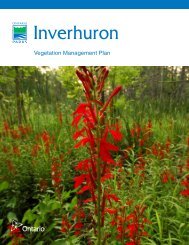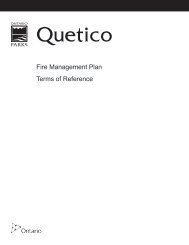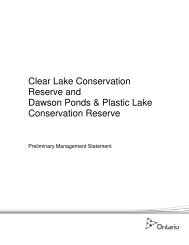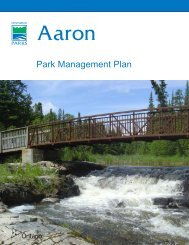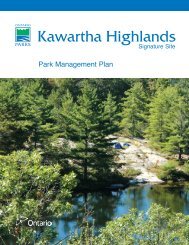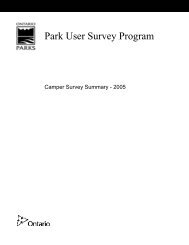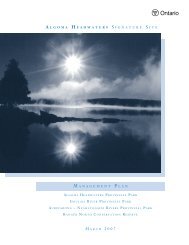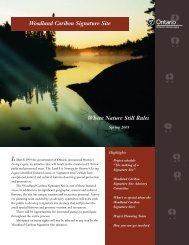Sandbanks Draft Veg Mgmt Plan - Ontario Parks
Sandbanks Draft Veg Mgmt Plan - Ontario Parks
Sandbanks Draft Veg Mgmt Plan - Ontario Parks
You also want an ePaper? Increase the reach of your titles
YUMPU automatically turns print PDFs into web optimized ePapers that Google loves.
APPENDIX A – Hazardous Tree Treatment Options<br />
Hazardous tree removal is restricted to development and historical zones, along<br />
roadsides, and along trails in natural environment and nature reserve zones. The<br />
following treatment options should be considered in the order given. Assessment of<br />
hazardous trees will be done by the park superintendent or designate.<br />
1. No action required<br />
No action is required for trees if they are:<br />
• Dead or living trees that are leaning away from trails, roadways, or facilities,<br />
provided the upturned root mass will not cause damage to trails or roads<br />
• Trees within naturalization areas of development zones that do not pose a risk to<br />
trail, roadways, or facilities outside the naturalization area<br />
2. Thinning of crown<br />
A hazardous tree may be treated by removal of selected limbs in the crown (thinning)<br />
when the trunk and base is sound and:<br />
• The tree has a slight lean or shows signs of shifting (heaving or cracking of soil).<br />
Removing part or all of the crown will reduce its weight and the stress on the<br />
lower trunk and roots<br />
• Weakness and rot is restricted to the upper crown/limbs<br />
• Limbs are interfering with power lines of buildings<br />
3. Cut top and upper limbs leaving bare trunk<br />
Trim back the crown and limbs to the main trunk(s) and limbs, relieving stress on the<br />
root system and reducing the possibility of the tree falling while leaving valuable wildlife<br />
habitat. Document the location of these trees and inspect annually. Use this method<br />
when:<br />
• The tree is located in a campground and day use areas and has significant rot or<br />
weakness in the crown or upper limbs but sound trunk and base.<br />
• Rot is present in the trunk, but enough sound wood is left to support a bare trunk.<br />
• The tree is a softwood or crotched oak.<br />
4. Felling<br />
Felling of a hazardous tree is the final recourse when options 1 to 3 are not adequate to<br />
ensure the safety of park users and facilities. Complete removal is necessary only<br />
when:<br />
• The base will not provide support to a bare trunk<br />
• The tree is leaning such that the root system will not be able to support it, or a<br />
hazard is created by the uplifted roots<br />
• There is substantial cracking in the trunk, indicating that the tree will likely fall<br />
due to wind or to ice accumulation<br />
• When limbing or crown removal is not safe for the cutter/feller or park staff<br />
Unless they obstruct a roadway, trail, or facility or create a safety hazard, felled trees<br />
should be left in place.<br />
<strong>Sandbanks</strong> <strong>Veg</strong>etation Management <strong>Plan</strong> A-1<br />
<strong>Ontario</strong> <strong>Parks</strong>, SE Zone<br />
2009





